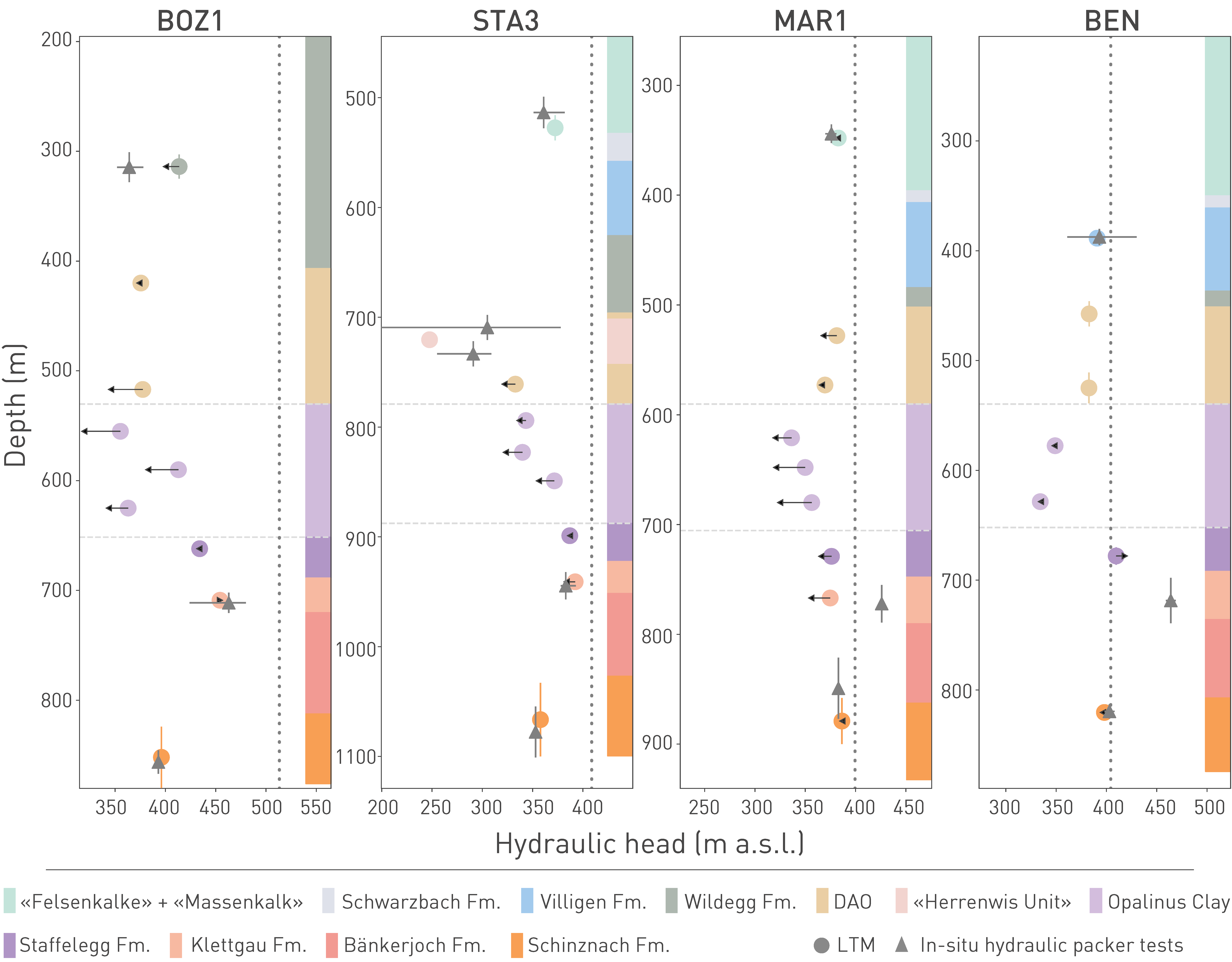Hydraulic head profiles along boreholes can support the identification of potential release paths and are used to estimate vertical hydraulic gradients between the host rock and the confining units, and the local and regional aquifers (Nagra 2024m). In addition, the values recalculated to pore pressures feed into geomechanical interpretation.
In principle, formation hydraulic heads can be estimated in two ways: From the analyses of the hydraulic packer tests, and from the hydrogeological long-term monitoring systems, directly measured in selected boreholes and intervals.
Regarding the hydraulic packer tests, the test strategies and test design were optimised notably for testing low-permeability clay-mineral-rich rocks based on earlier experience (Nagra 2001, Nagra 2002, Marschall et al. 2004, Reinicke & Frieg 2021). The hydraulic packer test analyses provide reliable and well constrained estimates of the transmissivity and hydraulic conductivity. The formation hydraulic head in the units with low clay-mineral content, particularly in the Malm, Keuper and Muschelkalk aquifers, is also well defined by the hydraulic test results. Despite the improved testing strategy, the estimated hydraulic heads in test intervals located in low-permeability clay-mineral-rich rock are considered to be strongly biased by artefacts (see also Nagra 2002, Beauheim 2013) and are therefore termed 'apparent heads'. They are not representative of formation hydraulic heads and are therefore not further discussed here.
As in other investigation programmes of low-permeability clay-rich rocks (e.g. Distinguin & Lavanchy 2007, NWMO 2011), hydrogeological long-term-monitoring (LTM) systems are used instead of short-term hydraulic tests to derive representative hydraulic heads or formation pore pressures. In addition to the pre-existing LTM system in the Benken (BEN) borehole, three additional boreholes were equipped (MAR1, STA3, BOZ1), that is one per siting region. The LTM systems are intended to measure the undisturbed formation hydraulic heads and their temporal fluctuations in the Opalinus Clay, the confining units and the deep aquifers. Measurements with the new LTM systems started in late spring 2022. While the pressures in many intervals are still evolving, the following conclusions can be formulated for the moment (with the focus on host rock and confining units):
-
The monitoring system in the BEN borehole records the hydraulic heads since 2009 (installation of the Baker-Hughes system). After 15 years of operation, the values in the Opalinus Clay are still slowly declining and are the lowest in the monitored units. Currently (Longridge et al. 2024), the measured hydraulic head in the Opalinus Clay is ca. 335 m a.s.l., that is 69 m below hydrostatic and ca. 56 m lower than in the Malm aquifer.
-
The hydraulic heads measured in the new boreholes seem to evolve like those measured in the BEN borehole. That is, the formation hydraulic heads in the Opalinus Clay are below hydrostatic (Fig. 5‑44) and lower than in the adjacent aquifers.
-
The hydraulic head in the «Herrenwis Unit» of the STA3 borehole is also subhydrostatic and lower than the discharge level of the Malm aquifer along the Rhine River (Fig. 4‑91).
In the scientific literature, values of hydraulic heads that cannot be explained solely by gravity-driven flow are termed 'anomalous heads' or 'anomalous pore pressures' (e.g. Neuzil 1995, Birchall et al. 2022). Many examples worldwide have been reported. They are believed to arise when processes cause sufficiently large changes in pore volume or fluid volume that cannot be dissipated by flow in the low-permeability formation (Horseman et al. 1996). Typical processes invoked to cause underpressures are stress release either because of erosion or after melting of Pleistocene ice cover (e.g. Beauheim 2013, Normani et al. 2017). These anomalous heads are an indication of very low hydraulic conductivity.
The hydraulic diffusivity is the measure of the ability of a porous medium to dissipate pressure. For the Opalinus Clay it is estimated at ca. 10-8 s-1 (K ~ 10-14 m/s, Ss ~ 10-6 m-1) and is well within the range of examples worldwide with observed anomalous pressures (literature overview in Vinard 1998, Neuzil 2015).

Fig. 5‑44:Hydraulic head profiles based on hydrogeological long-term monitoring and in-situ hydraulic packer test data in the BOZ1, STA3, MAR1 and BEN boreholes
Status of the long-term monitoring data is 01.05.2024. Hydraulic heads of the long-term monitoring systems are displayed using full circles. The extent of the intervals in contact with the formation is shown with a vertical line (in many cases the interval is smaller than the size of the data points). Left-pointing and right-pointing arrows respectively indicate decreasing and increasing hydraulic head with time (i.e. not yet stabilised). The length of the arrows is proportional to the magnitude of the rate of change of the hydraulic head with respect to time. No arrows are displayed for intervals with an absolute rate of change smaller than approximately 3 mm/day (about 1 m/yr). Hydraulic heads estimated from hydraulic packer tests are displayed with grey triangles. The associated horizontal and vertical lines show the uncertainty range of the hydraulic head value and the extent of the tested interval respectively. Hydraulic head estimates from hydraulic packer tests in low-permeability clay-rich units are affected by artefacts and are not shown (see text). Vertical dotted lines indicate the ground level. DAO: Dogger Group above Opalinus Clay, Fm.: Formation.

